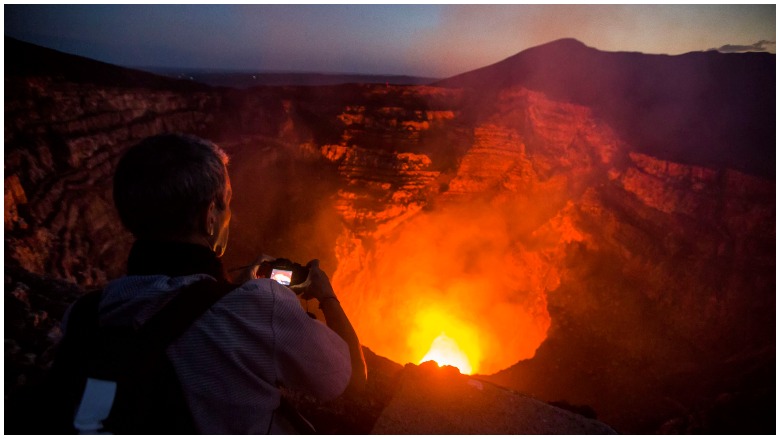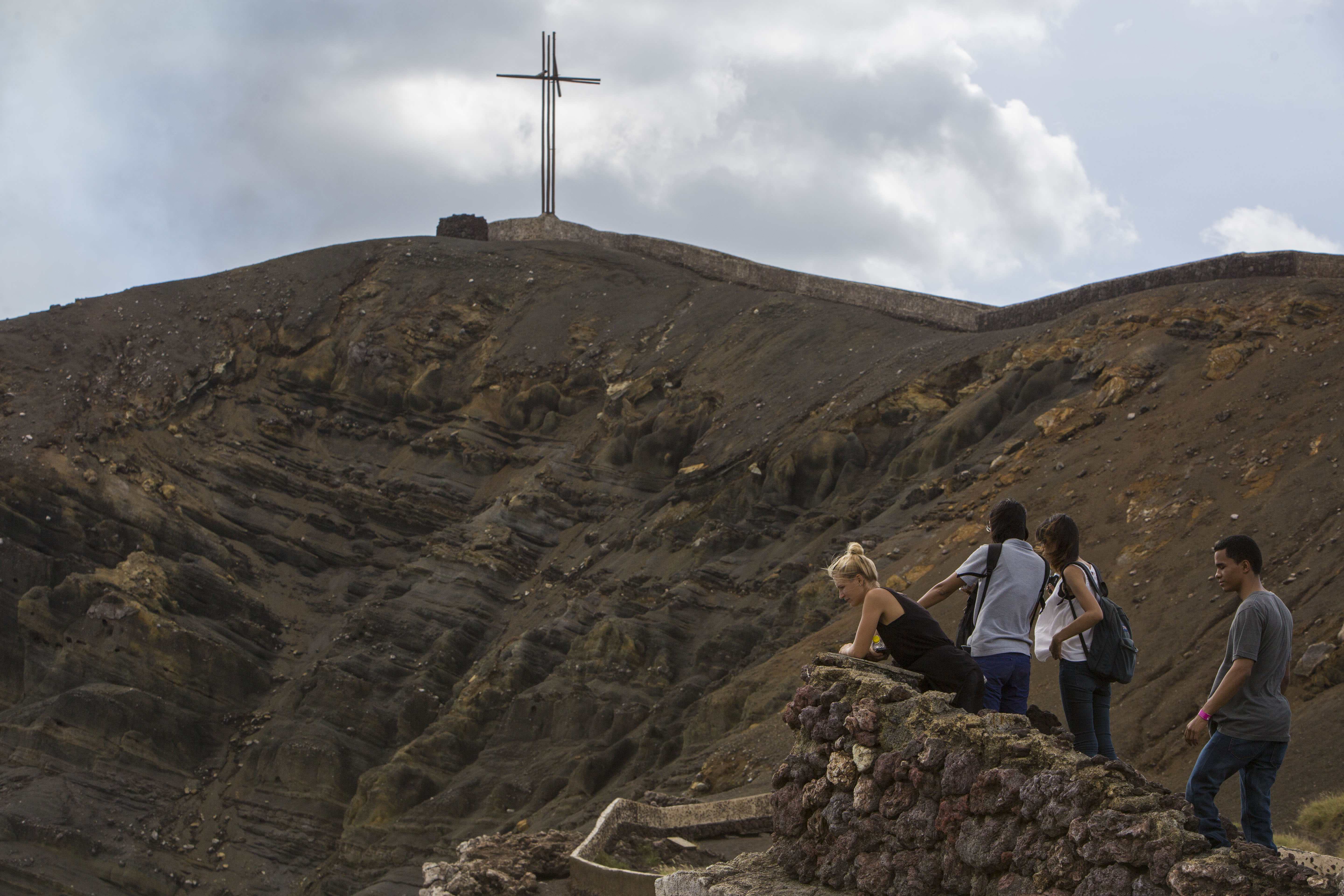
Getty Masaya volcano
Highwire artist Nik Wallenda made history on March 4, 2020, by walking 1,800 feet across the active Masaya volcano in Nicaragua. Wallenda completed the walk in 31 minutes.
The volcano is known as the “Mouth of Hell.” It has a lava lake flowing in the crater that Wallenda had to see, and hear, as he made the dangerous trek. For this walk, Wallenda had to wear goggles and a mask to protect himself from the sulfurous fumes the volcano emits.
Here’s what you need to know about the Masaya volcano.
1. Spanish Conquistadores Theorized Masaya Was the Gate to Hell & Indigenous Groups Made Human Sacrifices to the Volcano
The importance of the Masaya volcano dates back several centuries. According to an academic article published in the Journal of Volcanology and Geothermal Research in 2008, indigenous groups believed Masaya was a god. Spanish colonialist and historian Gonzalo Fernández de Oviedo y Valdés wrote in his 1851 book, “Historia General Y Natural de Las Indias,” that native peoples tossed children and young women into the crater as human sacrifices.
Oviedo y Valdés also wrote that native communities believed a sorceress, described as “an old woman with long and spiky hair, sharp fangs and breasts reaching her waist,” lived in the volcano.
But it was the Spanish conquistadores who referred to Masaya as the “mouth of Hell.” They arrived in Nicaragua in 1522. Two years later, both Masaya and the nearby Momotombo volcano erupted. This was the first time volcanic activity was recorded in the region.
Governor Pedrarias Davila wrote a letter to Emperor Carlos V in 1525 describing the volcanic activity. The letter read in part, “In this province of Masaya there is a large mouth of fire which never ceases to burn and during the night it is so big as if it reaches the sky, and with a height of 15 leagues (75km) there is light as if it was day.”
Oviedo y Valdes wrote of the lava lake, “At the bottom of that hole there was a fire that was liquid as water and that matter was burning more fiercely than red hot coal and more ardent in colour; burning more than any fire can ever burn, if that is possible. All of that matter filled the bottom of the hole and was boiling.”
Historians say explorers were curious to learn whether the lava within the crater of the volcano could contain gold, silver, or other valuable materials. The first attempt took place in 1538 by Friar Blas del Castillo. He carried a wooden cross with him to “so scare away the demons” as he descended. After several attempts, the friar and his team eventually managed to collect samples of the rocks but did not find gold.
2. Masaya Is One of the Few Volcanoes With a Lava Lake, Which Has Disappeared & Reformed Over the Centuries

Tourists take pictures of a lava lake inside the crater of the Masaya Volcano
Masaya is one of only a handful of volcanoes that contain a lava lake, which is actually composed of molten rock. These lakes have also been recorded in Hawaii’s Kilauea volcano and at the Nyiragongo volcano in the Democratic Republic of Congo, Phys.org reports.
But the lava lake has not been continually churning for centuries. The lava is known to recede and reappear. The current lake, which Wallenda will walk above, formed in 2015. It has the fastest churning lava on record, ABC reports.
According to the Journal of Volcanology and Geothermal Research, Masaya’s lava lake existed for at least 150 years in one segment of history. The Spanish conquistadores first saw it in 1522. But after an explosion in 1670, the lava lake disappeared.
Masaya again contained an active lava lake between 1965 and 1979, according to Oregon State University. The institution also says an eruption dating back to 4500 B.C. “was one of the largest on Earth in the last 10,000 years.”
3. A Major Explosion In 1772 Caused Lava to Flow For Eight Days
Strong earthquakes shook the region on March 16, 1772. The Masaya crater also erupted and caused lava to flow for eight days. The lava extended more than four miles north and 2.5 miles to the southeast.
According to the academic journal referenced higher in this article, a story emerged following the dangerous lava flow. The Bishop of Granada led a procession of people to face the lava flow, which was threatening communities. Miraculously, the lava stopped and did not harm the people. The journal reported the Bishop was carrying “the image of the Christ of Nindiri.” In another version of the story, the religious man was carrying a statue of the Virgin Mary, according to the children’s book “Celebrating Hispanic Culture” by Cynthia Downs. But both accounts explain that communities in the region commemorate this event on March 16 each year with religious processions.
There is a concern that a future lava flow could be more destructive than the 1772 event. Nicaraguan geographer and environmentalist Jaime Incer explained to Phys.org that the lava levels rise each time the lake reforms in the volcano. A future blast could trigger a lava flow that could impact areas up to 18 miles away from Masaya and endanger millions of people.
4. Scientists Say Masaya Could Erupt Without Warning Because Its Magma Is Located Two Miles From the Crater
Scientists carefully monitor Masaya’s activity in order to anticipate the next eruption. Volcanologist Jeffrey B. Johnson explained to ABC News that researchers watch for early warning signs by listening to the volcano. “Volcanoes like to speak in sounds low frequency sounds that humans can’t perceive, called infrasound. So we develop the sensors that we can deploy to listen to the volcano talk to us.”
However, scientists also say these early warning systems may not be enough at Masaya. In 2018, researchers from Penn State University used satellite imaging to investigate the areas surrounding the center of the Masaya volcano. The team’s findings, which were published in Geophysical Research Letters, were that Masaya has a supply of magma that extends nearly two miles away from the volcano’s crater.
The team explained in a news release why this is such a major discovery: “This shows that volcanoes can be fed magma through nearby underground channels and could help explain how volcanoes can erupt seemingly without warning because the active center of the volcano exhibits little deformation activity.”
5. The Masaya Volcano Is a Top Tourist Attraction In Nicaragua But Visitors’ Time At the Top Is Limited Due to the Risk From the Fumes

Masaya volcano in Nicaragua
The Masaya volcano, which is located within a national park is a major tourist attraction in Nicaragua, especially since the lava lake reformed in 2015. The volcano is located at the center of the park, about 12 miles away from the city of Managua.
A Christian cross stands near the crater, as well. According to the tourist website VisitCentroAmerica.com, the cross is situated in the same spot where the Spanish friar Francisco de Bobadilla erected one in 1529. Historians say he planted the cross in an attempt to “exorcise the devil” from the volcano.
Visitors are allowed to stay near the crater for only a few minutes due to the toxic fumes the volcano emits. Again, that is why Nik Wallenda will be equipped with goggles and a mask as he walks directly overtop the mouth of the volcano.
READ NEXT: What Happens If Nik Wallenda Falls?
Comments
Masaya Volcano, the Mouth of Hell: 5 Fast Facts You Need to Know